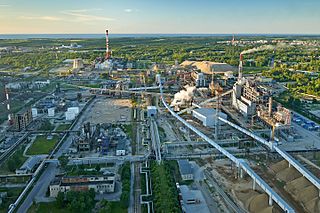Related Research Articles

Oil shale is an organic-rich fine-grained sedimentary rock containing kerogen from which liquid hydrocarbons can be produced, called shale oil. Shale oil is a substitute for conventional crude oil; however, extracting shale oil is costlier than the production of conventional crude oil both financially and in terms of its environmental impact. Deposits of oil shale occur around the world, including major deposits in the United States. A 2016 estimate of global deposits set the total world resources of oil shale equivalent of 6.05 trillion barrels of oil in place.
Unconventional oil is petroleum produced or extracted using techniques other than the conventional method. Industry and governments across the globe are investing in unconventional oil sources due to the increasing scarcity of conventional oil reserves. Unconventional oil and gas have already made a dent in international energy linkages by reducing US energy import dependency.
Shale oil is an unconventional oil produced from oil shale rock fragments by pyrolysis, hydrogenation, or thermal dissolution. These processes convert the organic matter within the rock (kerogen) into synthetic oil and gas. The resulting oil can be used immediately as a fuel or upgraded to meet refinery feedstock specifications by adding hydrogen and removing impurities such as sulfur and nitrogen. The refined products can be used for the same purposes as those derived from crude oil.

The Shell in situ conversion process is an in situ shale oil extraction technology to convert kerogen in oil shale to shale oil. It is developed by the Shell Oil Company.

The oil shale industry is an industry of mining and processing of oil shale—a fine-grained sedimentary rock, containing significant amounts of kerogen, from which liquid hydrocarbons can be manufactured. The industry has developed in Brazil, China, Estonia and to some extent in Germany and Russia. Several other countries are currently conducting research on their oil shale reserves and production methods to improve efficiency and recovery. Estonia accounted for about 70% of the world's oil shale production in a study published in 2005.

Shale oil extraction is an industrial process for unconventional oil production. This process converts kerogen in oil shale into shale oil by pyrolysis, hydrogenation, or thermal dissolution. The resultant shale oil is used as fuel oil or upgraded to meet refinery feedstock specifications by adding hydrogen and removing sulfur and nitrogen impurities.
Oil shale economics deals with the economic feasibility of oil shale extraction and processing. Although usually oil shale economics is understood as shale oil extraction economics, the wider approach evaluates usage of oil shale as whole, including for the oil-shale-fired power generation and production of by-products during retorting or shale oil upgrading processes.

Environmental impact of the oil shale industry includes the consideration of issues such as land use, waste management, and water and air pollution caused by the extraction and processing of oil shale. Surface mining of oil shale deposits causes the usual environmental impacts of open-pit mining. In addition, the combustion and thermal processing generate waste material, which must be disposed of, and harmful atmospheric emissions, including carbon dioxide, a major greenhouse gas. Experimental in-situ conversion processes and carbon capture and storage technologies may reduce some of these concerns in future, but may raise others, such as the pollution of groundwater.

The history of the oil shale industry started in ancient times. The modern industrial use of oil shale for oil extraction dates to the mid-19th century and started growing just before World War I because of the mass production of automobiles and trucks and the supposed shortage of gasoline for transportation needs. Between the World Wars oil shale projects were begun in several countries.
Enefit American Oil is a Utah based oil shale exploration and development company. It has been involved in the development of oil shale since 2005. Since 2011 it is a subsidiary of Eesti Energia, internationally known as Enefit.
Independent Energy Partners, Inc. (IEP) is an oil shale resources company based in Parker, Colorado, the United States. It is a developer of the Geothermic Fuels Cells Process, an in-situ shale oil extraction process. CEO of the company is Alan K. Forbes.
Mountain West Energy, LLC is an American unconventional oil recovery technology research and development company based in Orem, Utah. It is a developer of the In-situ Vapor Extraction Technology, an in-situ shale oil extraction technology. The company owns 880 acres (3.6 km2) oil shale leases in the Uintah Basin, Uintah County, Utah.
Oil shale in China is an important source of unconventional oil. A total Chinese oil shale resource amounts of 720 billion tonnes, located in 80 deposits of 47 oil shale basins. This is equal to 48 billion tonnes of shale oil. At the same time there are speculations that the actual resource may even exceed the oil shale resource of the United States.
Chevron CRUSH is an experimental in situ shale oil extraction technology to convert kerogen in oil shale to shale oil. The name stands for Chevron's Technology for the Recovery and Upgrading of Oil from Shale. It is developed jointly by Chevron Corporation and the Los Alamos National Laboratory.
ExxonMobil Electrofrac is an in situ shale oil extraction technology proposed by ExxonMobil for converting kerogen in oil shale to shale oil.
The Paraho process is an above ground retorting technology for shale oil extraction. The name "Paraho" is delivered from the words "para homem", which means in Portuguese "for mankind".
Omnishale process is an in situ shale oil extraction technology to convert kerogen in oil shale to shale oil. This process is classified as an externally generated hot gas technology. The technology is developed by General Synfuels International, a subsidiary of Earth Search Sciences.
The LLNL RISE process was an experimental shale oil extraction technology developed by the Lawrence Livermore National Laboratory. The name comes from the abbreviation of the Lawrence Livermore National Laboratory and words 'rubble in situ extraction'.

Genie Energy Ltd. is an American energy company headquartered in Newark, New Jersey. It is a holding company comprising Genie Retail Energy, Genie Retail Energy International, Genie Energy Services, and Genie Energy Oil and Gas.
The history of the oil shale industry in the United States goes back to the 1850s; it dates back farther as a major enterprise than the petroleum industry. But although the United States contains the world's largest known resource of oil shale, the US has not been a significant producer of shale oil since 1861. There were three major past attempts to establish an American oil shale industry: the 1850s; in the years during and after World War I; and in the 1970s and early 1980s. Each time, the oil shale industry failed because of competition from cheaper petroleum.
References
- 1 2 "Total buys 50 pct stake in AMSO to sell shale oil". Reuters. 2009-01-14. Retrieved 2009-02-14.
- 1 2 3 4 "First Quarter 2016 Results". Genie Energy. Archived from the original on 2019-02-11. Retrieved 2016-08-02.
- 1 2 "IDT Corporation Introduces Shale Oil Division" (Press release). IDT Corporation. 2008-02-15. Retrieved 2016-08-03.
- ↑ "IDT grabs share of shale" . Upstream Online . NHST Media Group. 2008-01-22. Retrieved 2008-08-18.
- 1 2 3 "Preliminary Information Statement". Genie Energy. Retrieved 2011-10-11.
- 1 2 3 4 5 "Quarterly Report (Form 10-Q)". Genie Energy. 2016-05-10. Retrieved 2016-08-03.
- ↑ Tsai, Catherine (2012-08-31). "BLM OKs 2 more Colo. oil shale research leases". Bloomberg Businessweek . Associated Press. Archived from the original on 2012-09-03. Retrieved 2012-11-18.
- ↑ Farnham, Alan (2012-11-13). "An American Oil Find That Holds More Than All of OPEC". ABC News . Retrieved 2012-11-18.
- ↑ Burnham, Alan K.; Day, Roger L.; Hardy, Michael P.; Wallman, P. Henrik (2010). "AMSO's novel approach to in-situ oil shale recovery". Oil Shale: A Solution to the Liquid Fuel Dilemma. Agapito Associates. pp. 149–160. doi:10.1021/bk-2010-1032.ch008. ISBN 9780841225398.
- 1 2 "Plan of Operation for Oil Shale Research, Development and Demonstration (R,D/D) Tract" (PDF). E.G.L. Resources, Inc. 2006-02-15. Archived from the original (PDF) on 2009-05-09. Retrieved 2008-05-01.
- ↑ "RD&D Leases. Testing a New Generation of Technology". Center of the American West. Archived from the original on 2011-04-18. Retrieved 2011-10-11.
- ↑ Fang, Chaohe; Zheng, Dewen; Liu, Dexun (2008-10-13). Main Problems in Development and Utilization of Oil Shale and Status of In-Situ Conversion in China (PDF). 28th Oil Shale Symposium. Golden, Colorado: Colorado School of Mines . Retrieved 2011-10-28.
- ↑ Secure Fuels from Domestic Resources: The Continuing Evolution of America's Oil Shale and Tar Sands Industries (PDF) (4 ed.). United States Department of Energy. September 2011. pp. 8–9. Archived from the original (PDF) on 2011-04-27. Retrieved 2012-11-18.
- ↑ "Innovation in Shale Technology". EGL Shale. 16 November 2006. Archived from the original on 20 June 2007. Retrieved 6 July 2007.